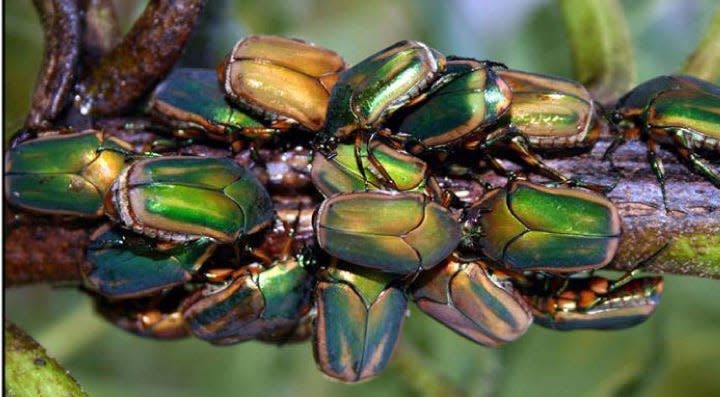Spring season means warm weather, flowers blooming and a visit from the plant eating green June beetle.
“They begin to appear around late May, early June depending on where you are in the state,” said Will Hudson, extension entomologist and professor for the Department of Entomology at the University of Georgia. “Where they’re likely to show up mostly has to do with soil temperature. They bury into the soil and emerge as adults in the spring.”
Hudson said adult green June beetles can be seen flying around in late May through September.
Spring season means more critters From fire ants to squirrels: Critters are on the move with the rising temperatures in Augusta
What do green June beetles look like?
Adult green June beetles are metallic green in color and can grow up to 1 inch in length. The pupae are brown in color and half-inch in length, according to experts with the North Carolina State University Extension.
Grubs are cream-colored and grow from one-quarter inch to 2 inches long. Grubs often hunch across the ground on their backs while extending their legs upward. Eggs are round, about one-sixteenth inch in diameter, and are laid in walnut-sized clusters of 10 to 30.
“The grubs feed on mostly organic matter in the soil,” said Hudson. “The adult females lay their eggs in the soil with a lot of organic content. That’s primarily what the grubs will feed on. Lighter, sandy soils makes it easier for the adults to dig in and lay their eggs and also easier for the larvae to move around and find food.”

Are green June beetles a pest?
Hudson said the green June beetle is known to wreak havoc on crops.
“In the course of tunneling they clip roots and loosen the soil,” said Hudson. “Loose soil dries out a whole lot faster than intact soil during times of relative drought. The adults can sometimes be problematic for people who grow fruit. They like to feed on ripe and overripe fruit. Especially fruit with thin skin like grapes and peaches. They’re notorious for getting into figs.”
Hudson said fruit trees that have started to rot are super attractive to green June beetles.
“It can literally sound like a beehive around a fig tree that someone isn’t taking care of or has completely abandoned,” said Hudson.

For crop growers, managing this particular beetle is an easy task compared to other pests, Hudson said.
“Compared to other white grub species that can be problematic to a variety of crops like Japanese beetles because they live underground,” he said. “These guys will come up to the surface. So they’re easily killed If you’re in a situation where you can use pesticides. But it doesn’t happen very often except in very specific situations.”
Hudson said the beetle is well known in the Deep South.
“They’re fairly robust and brightly colored,” he said. “ They’re very familiar insects. They have a tendency to fly low over turf grass areas in particular. So anybody who plays golf sees these beetles a lot. In fact, when I was a kid we used to catch them and tie thread around their legs and fly them around like airplanes. We didn’t have video games.
“And when they got tired, they quit flying. So you just take the thread off that one and catch another one. There were so many that they were everywhere.”
This reporting content is supported by a partnership with several funders and Journalism Funding Funding Partners.
Erica Van Buren is the climate change reporter for The Augusta Chronicle, part of the USA TODAY Network. Connect with her at EVanBuren@gannett.com or on X: @EricaVanBuren32.
This article originally appeared on Augusta Chronicle: Spring season prime time for plant eating Green June Beetles
Signup bonus from





